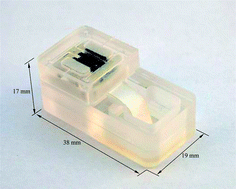A self-heating cartridge for molecular diagnostics†
Abstract
A disposable,

* Corresponding authors
a
Department of Mechanical Engineering and Applied Mechanics, University of Pennsylvania, 229 PhiladelphiaTowne, Building 220 South 33rd St, Philadelphia, Pennsylvania, USA
E-mail:
bau@seas.upenn.edu
Fax: +1 215 573-6334
Tel: +1 215 898-8363
A disposable,

 Please wait while we load your content...
Something went wrong. Try again?
Please wait while we load your content...
Something went wrong. Try again?
C. Liu, M. G. Mauk, R. Hart, X. Qiu and H. H. Bau, Lab Chip, 2011, 11, 2686 DOI: 10.1039/C1LC20345B
To request permission to reproduce material from this article, please go to the Copyright Clearance Center request page.
If you are an author contributing to an RSC publication, you do not need to request permission provided correct acknowledgement is given.
If you are the author of this article, you do not need to request permission to reproduce figures and diagrams provided correct acknowledgement is given. If you want to reproduce the whole article in a third-party publication (excluding your thesis/dissertation for which permission is not required) please go to the Copyright Clearance Center request page.
Read more about how to correctly acknowledge RSC content.
 Fetching data from CrossRef.
Fetching data from CrossRef.
This may take some time to load.
Loading related content
